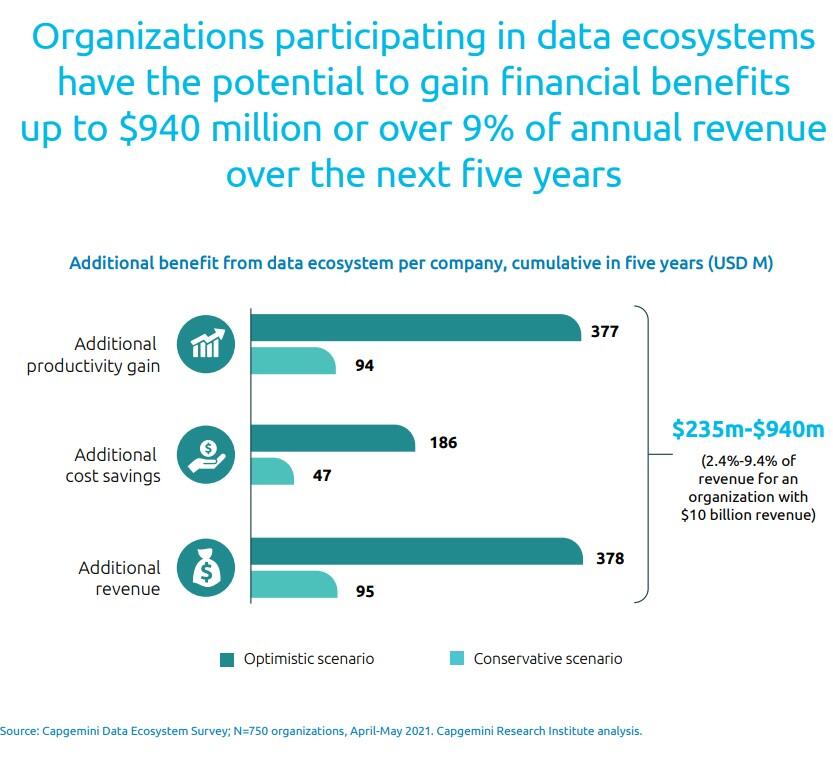The potential financial benefits can reach 9% of annual revenue over the next five years in an organization with $10 billion in annual revenue, a new Capgemini report finds.

Image: Jirsak/Shutterstock
Data sharing ecosystems—developed by organizations to share data and insights under locally applicable regulations to create value—have the potential to save organizations as much as 9% of their annual revenue over the next five years, according to a new report. Capgemini's latest report,"Data sharing masters: How smart organizations use data ecosystems to gain an unbeatable competitive edge," discusses the value for organizations across industries when they share data throughout their ecosystems of partners and suppliers.
These ecosystems can take different forms, including data brokerages providing aggregate data to clients, reciprocal data sharing among supply chain partners and sharing insights across sector boundaries, the report said.
SEE: Electronic Data Disposal Policy (TechRepublic Premium)
Organizations that engage in data ecosystems improve customer satisfaction by an average of 15%, improved productivity/efficiency by 14% and reduced costs by 11% annually in the last two to three years, according to the report.
Data ecosystems have existed in some form for over a decade, Capgemini said. "In one of the earliest forms of for-profit data ecosystems, banks, credit-card companies and lending institutes have been partnering with credit-reporting agencies and bureaus and sharing consumer-credit information,'' the report said.
- Today's data ecosystems have come a long way and possess several characteristics that stand out from those of the past:
- Complexity (multi-party, heterogeneous, including data from individuals as well as from businesses)
- Transparency: enable trust and participants' sovereignty over their data
- Openness and dynamism (easier to join, participate and leave)
- Following modern standards and technology for interoperability
- Ability to build on trusted software infrastructure.
Organizations are taking note
For example, data ecosystems are helping organizations run analytics on logistics partner data to better optimize supply chains, build a real end-to-end view of the sustainability impact of new products before launching them and learn from drug discovery data from many pharma companies to bring safer drugs to market faster, according to the report.

Image: Capgemini
Driven by business benefits, 48% of organizations are planning to launch new data ecosystem initiatives in the near future, with 84% of them planning to do so within the next three years, the Capgemini report said.
SEE: Snowflake data warehouse platform: A cheat sheet (free PDF) (TechRepublic)
The telecom (81%), banking (73%) and consumer goods (60%) sectors will lead the data-sharing race within the next three years, with the highest proportions of organizations that plan to launch new data ecosystem initiatives, the report said.
And at a geographic level, the U.S. (47%) will have the largest share of firms making major investment commitments (those investing >$50m) in the data ecosystem space.
One in four organizations (25%) will invest upwards of $50 million in data ecosystems in the next two to three years.
Data ecosystems cut across sectors, data domains and value chains
Data ecosystems are found and used across different sectors, data domains and value chains. The most common use cases among the 37 unique ecosystem use cases Capgemini analyzed are:
- Tracking advertising efficiency and targeting
- Sharing data and insights on new research and development
- Sharing product and service consumption and usage data
- Sharing aggregate mobility data for services such as smart cities, parking, mapping, etc.
- Sharing online purchase and transaction data.
Yet, the full potential of these data ecosystems is not yet being realized. A majority of organizations (61%) are engaging in simple data sharing and low levels of collaboration, the report said. Fourteen percent of organizations are engaged in more collaborative models with extensive data sharing.
SEE: 3 steps to build a data fabric to integrate all your data tools (TechRepublic)
Organizations involved in more collaborative data ecosystems have the potential to significantly outperform organizations in less complex and collaborative ecosystem models. Such organizations drive an additional 10 percentage points of financial advantage, including new revenue, higher productivity and lower costs in the next three years, according to the report.
"We believe that organizations following a clear roadmap for data ecosystem engagements will build a sustained advantage for themselves and their partners,'' the Capgemini report said. This roadmap involves:
- Formulating a data ecosystem strategy: clearly articulating the purpose of engaging in data ecosystems, identifying data-sharing use cases that create value, and establishing leadership and governance for data-sharing initiatives.
- Making key design decisions: deciding what data can be shared (sourced or supplied), who the trusted ecosystem partners will be, and which collaboration model and business model will work best.
- Kicking off implementation by running small-scale pilots, aligning required capabilities, analyzing processes that need to be transformed, and defining new internal ways of working.
- Sustaining the advantage by scaling up the use cases to their full potential; measuring and monitoring success; and moving up the data and insights value chain.
- Proactively addressing privacy, ethics, trust and regulatory requirements.

Data, Analytics and AI Newsletter
Learn the latest news and best practices about data science, big data analytics, and artificial intelligence. Delivered Mondays
Sign up todayAlso see
- Geospatial data is being used to help track pandemics and emergencies (TechRepublic)
- Akamai boosts traffic by 350% but keeps energy use flat thanks to edge computing (TechRepublic)
- How to become a data scientist: A cheat sheet (TechRepublic)
- Top 5 programming languages data admins should know (free PDF) (TechRepublic download)
- Data Encryption Policy (TechRepublic Premium)
- Volume, velocity, and variety: Understanding the three V's of big data (ZDNet)
- Big data: More must-read coverage (TechRepublic on Flipboard)







 English (US) ·
English (US) ·